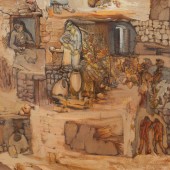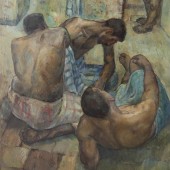Ahmed Nesha'at Al Zuaby
Ahmad Nasha’at Al Zuaby’s artistic process involves spiritual introspection as a means to create an image. Al Zuaby only begins to paint following a period of contemplation, when the scene he has been imagining has faded from his memory. Focusing on urban and rural landscapes as well as daily life, he tries to re-imagine and assemble indistinct scenes from the depths of his memory through painting. In 1956, he founded the Circle of Artists of Hama. Among the first to graduate from the Faculty of Fine Arts in Damascus in 1964, Al Zuaby also studied painting in Cairo and helped to establish the Fine Arts Association. As part of his graduation project in 1964, Al Zuaby created the piece featured here, The Bathers, which features underground baths in his Syrian hometown Hama. In the emotive scene, soft light penetrates from the thick crystal domes and mingles with the water fumes. The artist employs a solid academic approach along with a hazy palette of subdued colours, to embody his main objective: washing the spirits rather than the bodies. In 1969, Al Zuaby co-founded the Group of Ten for Modern Art, which included the pioneering Syrian artists Naim Ismail, Elias Zayat and Nazir Nabaa. His work was exhibited at the Triennial-India in New Delhi in 1971 and 8th Alexandria Biennial in 1970, and is also included in various public collections such as the National Museum of Damascus.
تنطوي سيرورة أحمد نشأت الفنية على التأمل الروحي للذات كوسيلة لإرساء ملامح الصورة. استهل الزعبي الرسم فقط بعد فترة من التأمل، عندما يبدأ المشهد الذي كان يتخيله بالتلاشي من ذاكرته. مركزاً على المناظر الحضرية والريفية فضلاً عن الحياة اليومية، يحاول إعادة تخيّل وتجميع المشاهد غير الواضحة من أعماق ذاكرته عن طريق الرسم. وأسس الزعبي الحلقة الفنية في حماة عام 1956، وكان من خريجي الدفعة الأولى لكلية الفنون الجميلة في دمشق عام 1964، كما درس أيضاً الرسم في القاهرة وساعد بتأسيس نقابة الفنون الجميلة. وفي إطار مشروع تخرجه عام 1964، أبدع لوحة بعنوان المستحمون سلط من خلالها الضوء على الحمامات تحت الأرض التي كانت منتشرة في مدينته حماة. وتصور اللوحة مشهداً عاطفياً حيث يخترق ضوء باهت القباب البلورية السميكة ويمتزج مع بخار الماء. ويعتمد الفنان أسلوباً أكاديمياً رصيناً إلى جانب مجموعة ضبابية من الألوان الخافتة لتجسيد هدفه الرئيسي المتمثل في غسل الأرواح بدلاً من الأجساد. وخلال عام 1969، شارك بتأسيس جماعة العشرة للفن الحديث والتي ضمّت الفنانين الرواد السوريين: نعيم إسماعيل وإلياس الزيات ونذير نبعة. وعرضت أعماله في ترينالي الهند في نيودلهي عام 1971، وفي بينالي الإسكندرية الثامن،1970، كما تتواجد أعماله في مقتنيات عامة مختلفة مثل متحف دمشق الوطني.
Related artists by country
- Diana Al Hadid
- Asaad Arabi
- Marwan
- Sabhan Adam
- Fateh Al Moudarres
- Nasha'at Al Zuaby
- Louay Kayyali
- Naim Ismail
- Nassir Choura
- Walid Al Shami
- Abdul Rahman Mowakket
- Ali Mokawas
- Fadi Al Hamwi
- Mahmoud Hammad
- Maysa Mohammed
- Nazir Ismail
- Ziad Dalloul
- Talal Moualla
- Amal Mulhem
- Adonis (Ali Ahmed Said Esber)
- Ahmad Moualla
- Ismail Al Rifai
- Ali Ferzat
- Ali Al Jabri
- Abdallah Murad
- Aula Al Ayoubi
- Bassem Dahdouh
- Sulafa Hijazi
- Zhivago Duncan
- Ahmad Durak Sibai
- Omar Hamdi
- Mohammed Masri
- Jaber Al Azmeh
- Sueraya Shaheen
- Abdalla Omari
- Safwan Dahoul
- Elias Zayat
- Adel Dauood
- Ammar Abd Rabbo
- Bassel Safadi
- Fares Cachoux
- Mazen Ismail Al-Ashkar
- Noor Bahjat
- Tammam Azzam
- Waseem Marzouki
- Khaldoun Shishakly
- Simone Fattal
- Khouzaima Alwani
- Nazir Nabaa
- Hind Zulfa
- Leila Nseir
- Mamdouh Kashlan
- Mahmoud Daadouch
- Majed Sabouni
- Khaled Akil
- Nagham Hodaifa
- Abdul Mannan Shamma
- Khalisa Hilal
- Said Tahsin
- Türki Mamud Bey
- Maysoun Jazairi





